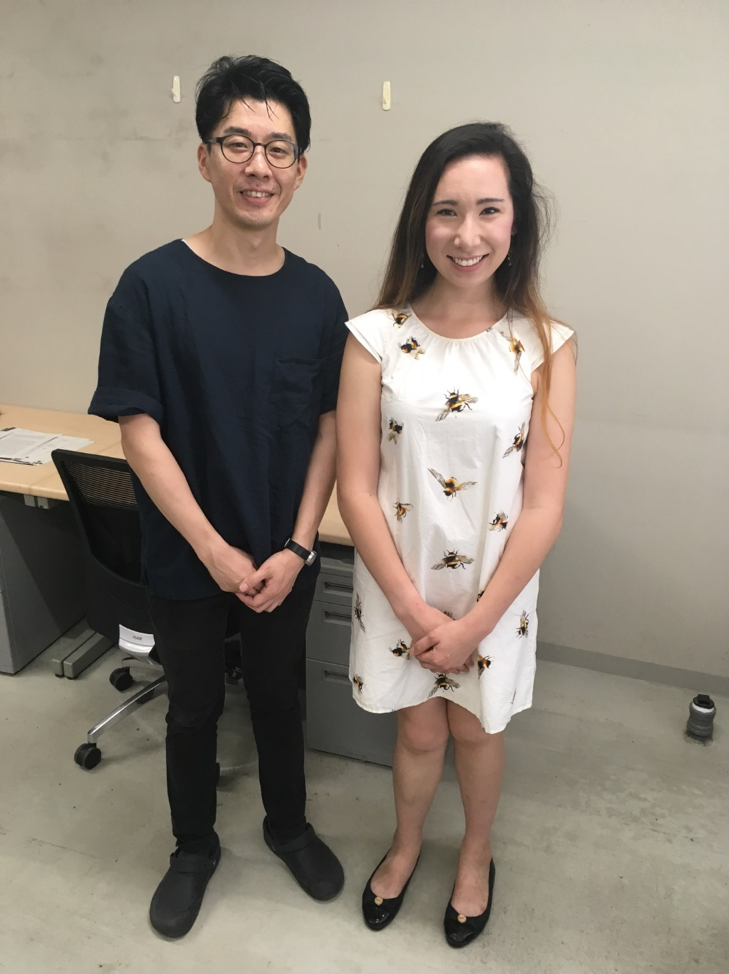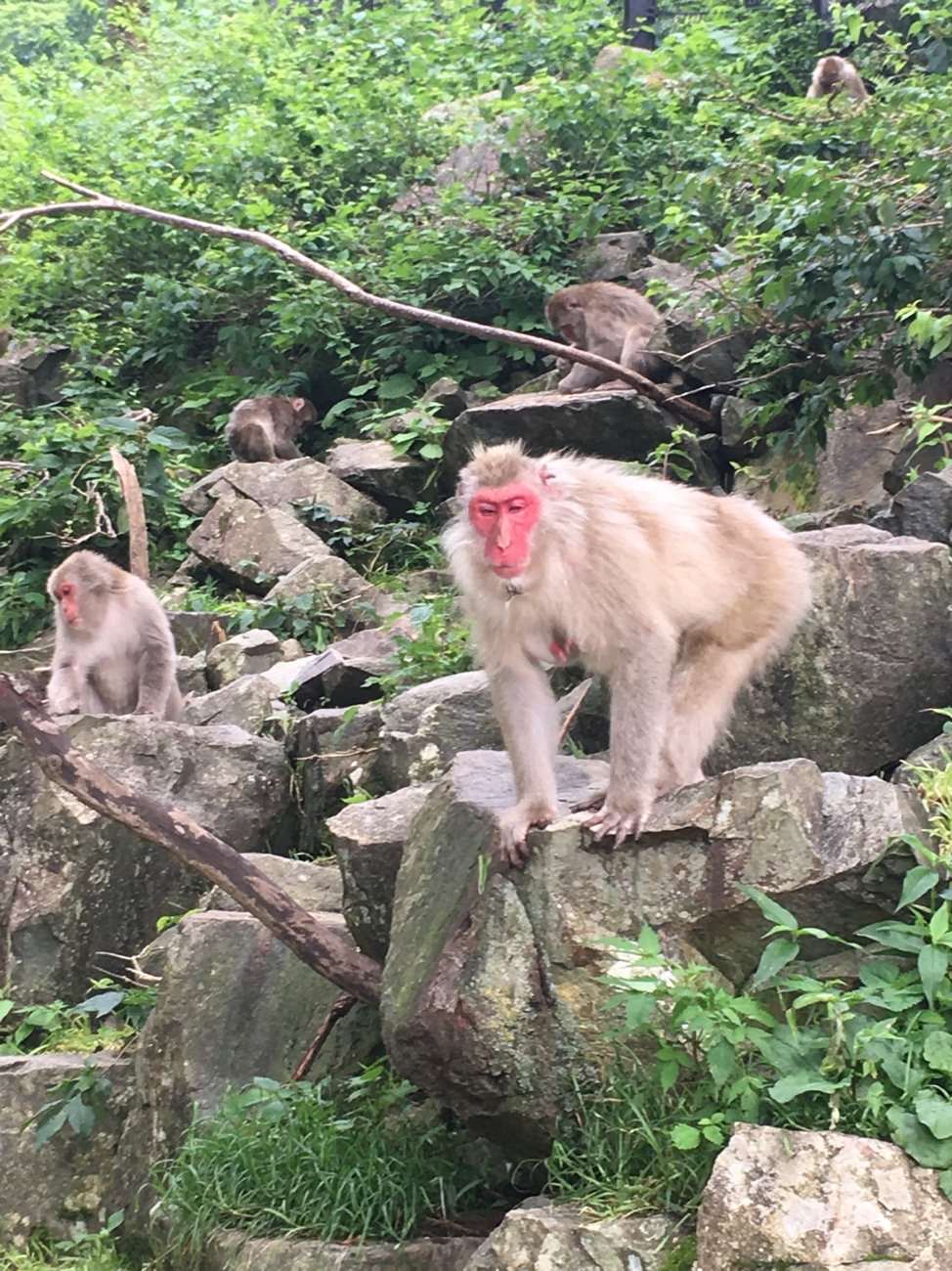Week 6: Bone biology, and Kyoto and Nagano excursions
Konnichiwa from the PRI! This past week was a busy one, with CT scanning of the femora under way and a visit to the , headed by , at the main campus of Kyoto University.
Bone Biology and My Research
As a refresher, one of the goals of my research this summer is to examine limb development in Japanese macaques in order to determine whether differences are in response to a temperature gradient or if this is a consequence of gradation due to gene flow. Some of the measures I will be using in order to make this determination include lengths of proximal and distal ends of long bones from the nutrient foramen. However, an understanding of basic bone biology and development is necessary to begin to understand how bone growth occurs and how different factors affect this growth in macaques.
Bone development progresses with the help of four types of cells: osteogenic cells, osteoblasts, osteocytes, and osteoclasts. Osteogenic cells from the surrounding connective tissue differentiate into new osteoblasts. Osteocytes are osteoblasts that become embedded in the matrix that they secrete called osteoid. As mineral salts deposit into the matrix, the osteoblasts are trapped within and become osteocytes. Osteoclasts degrade bone and aid in bone remodeling.

Source:
The interactions of these cells help form and maintain the bone. There are two types of bone, cortical and trabecular. Trabecular bone is spongy-type matrix that makes up the internal areas of bones; it is very porous. The remaining matrix is filled with marrow and fat. Cortical bone is what surrounds the trabecular bone and is very hard, compact, and dense. The CT scans that are being taken will allow me to directly examine cortical and trabecular bone within the femora of the macaques.

Source:
Bone formation occurs from ossification centers. The primary ossification center is the first area where bone material starts to form, and typically appears in the central part of the bone. In long bones, this occurs in the diaphysis, which is the shaft of the bone. Primary ossification usually takes place prenatally. Most bones only have one primary ossification center (unlike the os coxa, long bones, and vertebrae). These ossification centers are fed by the nutrient artery, which runs through the nutrient foramen. That is why I measured from the nutrient foramen: it marks the initial center from which bone growth is occurring.
Secondary ossification centers are the areas of bone material that form after the primary center has appeared. There is typically more than one secondary ossification center. In long bones, they are located in the epiphyses, or ends of the shaft. Secondary ossification takes place postnatally and during adolescence. In adulthood, the bones formed from the ossification centers fuse together.

Source: Dermience, Michael. (2019). Kashin-Beck Disease: Evaluation of Mineral Intake in Young Tibetan Children from Endemic Areas.
Kyoto University
This past week was special, because I had the opportunity to visit the Laboratory of Physical Anthropology at the main campus of Kyoto University. was kind enough to take time from his busy schedule to guide me through the laboratory and collections.

Photo: Dr. Morimoto and me.
The laboratory is home to technology that is often unavailable at other institutions, such as a full medical CT scanner, a high resolution micro-CT scanner, a computer lab equipped with Amira-Avizo, and even a large 3-D printer to create physical, tangible reproductions of these scans. Having this technology regularly available makes data collection much easier than having to source machines to use at other institutions.
Kyoto University also houses an extensive Jomōn anthropological collection. The Jomōn were early Japanese hunter-gatherers from the period of ~14,000 to ~1,000 B.C.. The kanji letters used to write “Jomōn” stand for “rope pattern”, as these people used rope to create impression patterns in their pottery.
I am deeply grateful to Dr. Morimoto for hosting me in Kyoto and showing me the facilities and collections of the Laboratory of Physical Anthropology! It was a wonderful visit!
Kyoto: Ginkaku-ji Temple, Gion Matsuri, and Fushimi Inari Taisha
I also managed to do some sightseeing while in Kyoto. I visited the Ginkaku-ji Temple, which is famously known as the “silver pavilion”. However, you will notice in the picture that the temple is not actually covered in silver. Shogun Yoshimasa modeled this temple after the Kinkaku-ji (golden pavilion) and intended on covering the exterior in silver leaf. But, after extended construction delays and the shogun’s death, these plans were never carried out.
My visit to Kyoto coincided with the famous Gion Matsuri parade called Sama Matsuri Junko. I donned my yukata to watch the parade where 32 “yama” (floats) are pulled by hand down the route. Some of the yama weigh over 2 tons! It was an incredible sight to see, especially when they turn the yama in the intersections.
The next morning I woke at 4:30 a.m. to hike through Fushimi Inari Shrine, known for having over 10,000 torii gates (the red structures in the photos) to reach the summit of Mt. Inari, yielding incredible views of Kyoto during sunrise. Then I returned to Inuyama to continue my research.




Upper left: Kinkaku Temple. Upper right: Yama (float) from the Gion Matsuri parade.
Lower left: Me in yukata (summer kimono). Lower right: Torii (Gates) at Fushimi Inari Shrine.
Nagano: Togakushi and Jigokudani Monkey Park
After finishing up the week with more CT scanning, I hopped on the JR (Japan Railways) line to Nagano, home of the 1998 Winter Olympics. It is located northeast of Nagoya, nestled within the Japanese Alps. The views from the 3-hour train ride were breathtaking! After arriving in Nagano, I hiked up through the village of Togakushi where a lane of cedar trees ends at the Togakushi Upper Shrine. It was just drizzly enough for the fog to descend upon the alps, lending a serene mood to the forest.
On Sunday, I visited Jigokudani Monkey Park in Yamanochi, which was the purpose of the trip. You can see Japanese macaques, also known as snow monkeys, in the wild without any barriers. In the winter, they like to soak in the hot springs to keep warm! I am interested in exploring the osteometric/CT data of specimens collected from this area to see how use of onsen (hot springs) might affect macaque growth.


Left: Scene on the way to Jigokudani Monkey Park. Right: Macaques at the park.
Read my blog next week to learn more about long bone development, and a weekend excursion to Beppu and Oita to see more macaques!
Sayonara,

